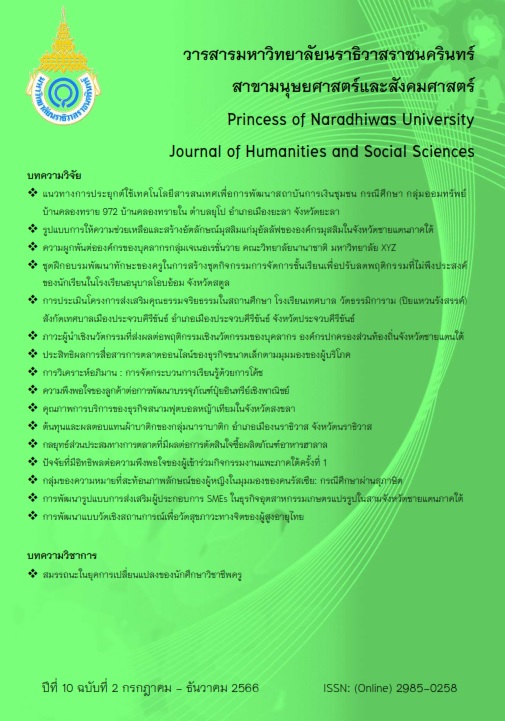ต้นทุนและผลตอบแทนผ้าบาติกของกลุ่มนาราบาติก อำเภอเมืองนราธิวาส จังหวัดนราธิวาส
Main Article Content
บทคัดย่อ
การวิจัยเชิงคุณภาพครั้งนี้มีวัตถุประสงค์เพื่อศึกษากรรมวิธีในการผลิตผ้าบาติก และศึกษาต้นทุนและผลตอบแทนของธุรกิจผ้าบาติก ประชากรที่ใช้ในการวิจัย ได้แก่ สมาชิกในกลุ่มนาราบาติก จำนวน 7 คน เครื่องมือที่ใช้ คือ แบบสัมภาษณ์ที่มีโครงสร้าง ใช้การวิเคราะห์เชิงพรรณนา ค่าร้อยละ คำนวณต้นทุน รายได้ และกำไรขั้นต้น ผลการวิจัยพบว่า ผ้าบาติกที่ถูกผลิตโดยกลุ่มนาราบาติกสามารถแบ่งออกเป็น 2 ประเภท คือ ผ้าบาติกแบบพิมพ์ลาย และผ้าบาติกแบบเขียนลาย ต้นทุนการผลิตผ้าบาติกแบบพิมพ์ลายเฉลี่ยอยู่ที่ 175.20 บาทต่อ 1 หลา และต้นทุนการผลิตผ้าบาติกแบบเขียนลายอยู่ที่ 264.22 บาทต่อ 1 หลา กำไรขั้นต้นจากการจำหน่ายผ้าบาติกรวมเฉลี่ยต่อเดือนอยู่ที่ 42,227 บาท โดยที่กำไรขั้นต้นจากการผลิตผ้าบาติกแบบพิมพ์ลายมีมูลค่าสูงกว่ากำไรขั้นต้นจากการผลิตผ้าบาติกแบบเขียนลายอยู่ที่ 38,360 บาท ผลจากการวิเคราะห์กำไรขั้นต้นแสดงให้เห็นว่า การผลิตผ้าบาติกแบบพิมพ์ลายให้ผลตอบแทนที่สูงกว่าการผลิตผ้าบาติกแบบเขียนลาย อย่างไรก็ตามทางกลุ่มนาราบาติกยังคงต้องผลิตอย่างต่อเนื่อง นอกเหนือจากเป็นการส่งเสริมเศรษฐกิจชุมชนให้เข้มแข็งสามารถพึ่งพาตนเองได้แล้ว อนึ่งผลงานของช่างบาติกที่ใช้ภูมิปัญญาเดิมในการเขียนลายบนผ้าบาติกนั้น ได้รับความนิยมจากกลุ่มอนุรักษ์ ทั้งนี้เป็นแนวทางสำหรับผู้ประกอบการธุรกิจในลักษณะเดียวกันในการนำข้อมูลที่ได้ไปพิจารณาลดต้นทุนการผลิต และหาแนวทางในการเพิ่มประสิทธิภาพในการผลิตเพื่อเพิ่มกำไรได้
Article Details

อนุญาตภายใต้เงื่อนไข Creative Commons Attribution-NonCommercial-NoDerivatives 4.0 International License.
เอกสารอ้างอิง
แก้วมณี อุทิรัมย์, จริญญา สันฐิติธนาวัฒน์, น้ำอ้อย จันทะนาม, แพรววิภา นิลแก้ว, และสุภาภรณ์ แสนทุนท้าว. (2560). การวิเคราะห์ต้นทุนและผลตอบแทนจากการทอผ้าไหมมัดหมี่ตีนแดง ตำบลนาโพธิ์ อำเภอนาโพธิ์ จังหวัดบุรีรัมย์. วารสารวิจัยและพัฒนา มหาวิทยาลัยราชภัฎบุรีรัมย์, 12(2), 116-124.
ดุษฎี บุญธรรม. (2556). การวิเคราะห์ต้นทุนการผลิตแท่งชิ้นงานในอุตสาหกรรมโดยใช้ระบบต้นทุน กิจกรรม. วารสารวิจัยและพัฒนา มจธ,36(2), 203-213.
ธวัชชัย ทุมทอง. (2545). ศิลปะการท้าบาติก ลายเขียนระบายสี. กรุงเทพฯ: โอเดียนสโตร์.
ธันยมัย เจียรกุล. (2557). ปัญหาและแนวทางการปรับตัวของ OTOP เพื่อพร้อมรับการเปิด AEC. วารสารนักบริหาร, 34(1),177-191.
นภาลัย บุญทิม. (2564). ต้นทุนและผลตอบแทนผ้าเขียนเทียนของกลุ่มอาชีพสตรีบ้านเล่าเน้งในอำเภอเขาค้อจังหวัดเพชรบูรณ์. วารสารวิจัยและพัฒนา มหาวิทยาลัยราชภัฎเลย, 16(58), 25-33.
นันทา โรจนอุดมศาสตร์. (2536). การทำผ้าบาติก. กรุงเทพฯ: โอเดียนสโตร์.
ประภาภรณ์ เกียรติกุลวัฒนา. (2555). วิวัฒนาการการบัญชีต้นทุน. จุฬาลงกรณ์ปริทัศน์, 34(134), 82-91.
พรรณนิภา รอดวรรณะ, ดวงมณี โกมารทัต, และบุญเสริม วิมุกตะนันท์.(2550). การวิเคราะห์ต้นทุนนํ้านมดิบของเกษตรกรและสมาชิกสหกรณ์โคนมในประเทศไทย. จุฬาลงกรณ์ปริทัศน์, 29(114), 62-70.
พรรณุภา ธุวนิมิตรกุล. (2558). การเงินธุรกิจ (พิมพ์ครั้งที่ 7). กรุงเทพฯ: คณะพาณิชยศาสตร์และการบัญชี มหาวิทยาลัยธรรมศาสตร์.
ภัทราผ้าไทย. (2558). ประวัติผ้าบาติก หรือผ้าปาเต๊ะ. สืบค้นจาก http://www.pattraphathaI.com/article
มีนา ภัทรนาวิก. (2557). เหลียวหลัง ...แลหน้า “บัญชีบริหาร” ของผู้ประกอบการไทย. จุลสารสมาคมการบัญชีไทย, 10(2), 24-26.
สมนึก เอื้อจิระพงษ์พันธ์. (2552). การบัญชีต้นทุน (พิมพ์ครั้งที่ 3). กรุงเทพฯ: สำนักพิมพ์แมคกรอ-ฮิล.
สมภพ อิ๋วสกุล. (2549). โชคบาติกศิษย์ลุงชู. กรุงเทพฯ: พริ้นท์ แอนด์ แพคเซอร์วสิไลน์.
สุขใจ ตอนปัญญา. (2554). ต้นทุนและผลตอบแทนในการลงทุนปลูกข้าวเกษตรกรหมู่ 5 ตำบลหัวดง อำเภอเมือง จังหวัดพิจิตร (การค้นคว้าอิสระปริญญาบริหารธุรกิจมหาบัณฑิต). มหาวิทยาลัยเทคโนโลยีราชมงคลธัญบุรี, ปทุมธานี.
สุพยอม นาจันทร์, ปทุมพร หิรัญสาลี, จุไรรัตน์ ทองบุญชู, วรกร ภูมิวิเศษ, และลักขณา ดำชู. (2559). ต้นทุนและผลตอบแทนในการลงทุนของกลุ่มหัตถกรรมบ้านชุมพอตำบลเกาะแต้ว อำเภอเมือง จังหวัดสงขลา. การประชุมวิชาการด้านมนุษย์ศาสตร์และสังคมศาสตร์ ระดับชาติ ครั้งที่ 2 “มนุษย์ ศาสตร์และสังคมศาสตร์ นวัตกรรมสร้างสรรค์สังคม” (หน้า 923-939). สงขลา: มหาวิทยาลัยราชภัฏสงขลา.
Krabi batik. (2554). ประวัติผ้าบาติก. สืบค้นจาก https://krabibatik.wordpress.com
Sunarya, Y. Y. (2016). Identity of Indonesian Textile Craft: Classic to Modern Batik (Research report). Indonesia: Faculty of Visual Art and Design Bandung Institute of Technology.


